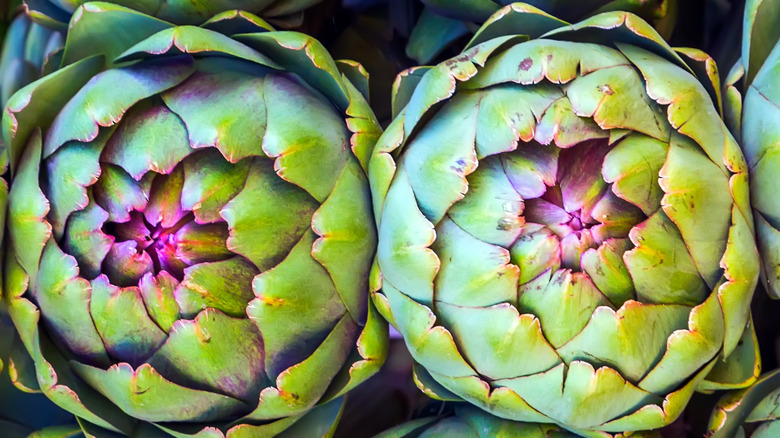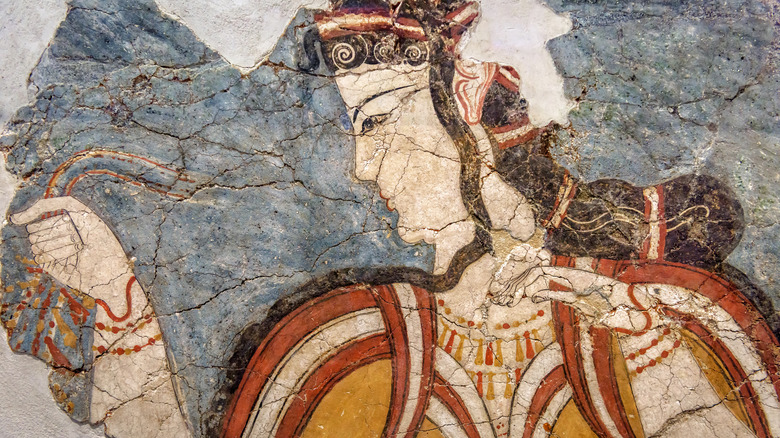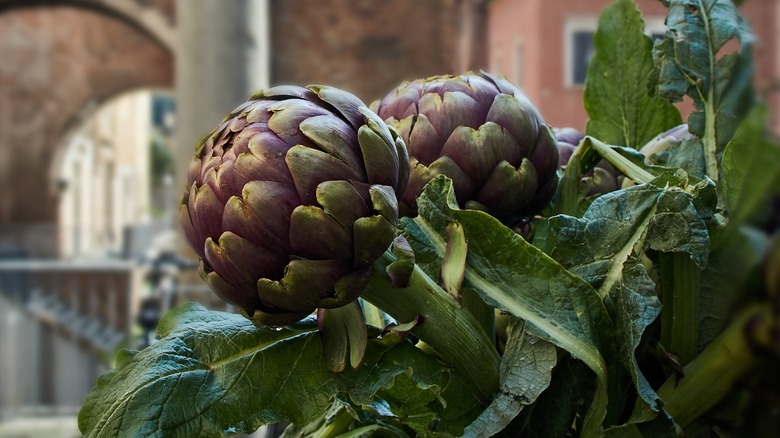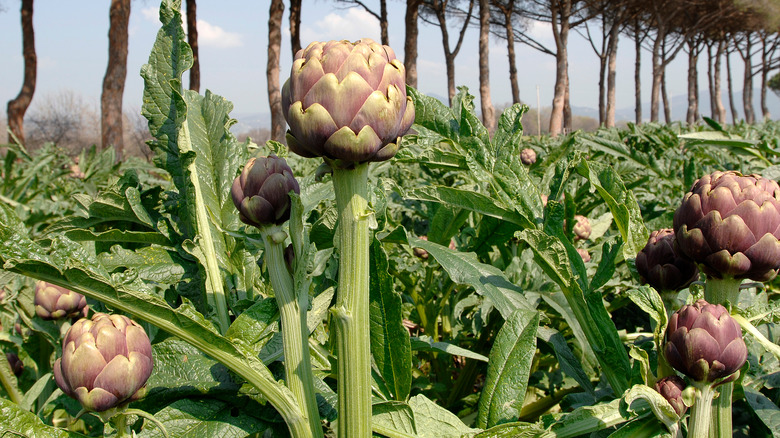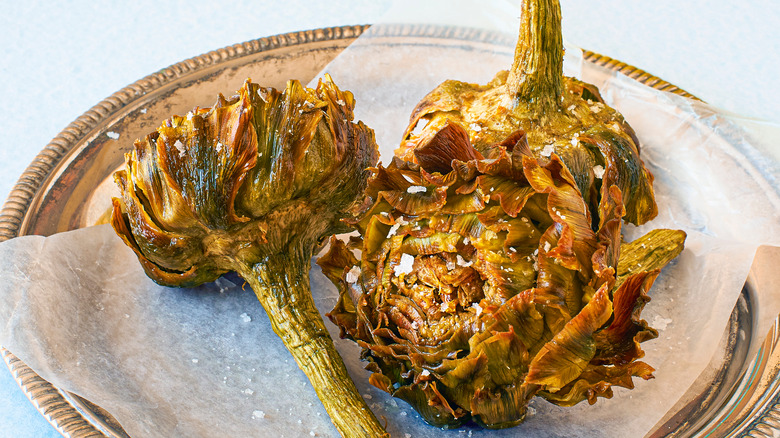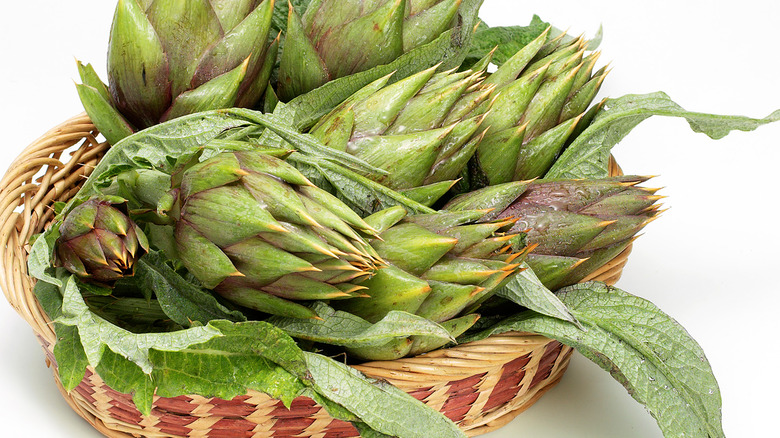This Country Produces The Most Artichokes Worldwide
Of course, Italian food is iconic. Pasta, pizza, pesto, wine, cheese — we could go on and on. But there is one vegetable that grows across the peninsula that the Italians absolutely love: artichokes.
According to Atlas Big, worldwide artichoke production totals 1,594,385 metric tons per year. Of the three countries that grow the most artichokes, Italy tops the pack at 378,820 metric tons per year. Egypt comes second at 296,899 metric tons, and Spain rounds out the trifecta at 199,940 metric tons. These three countries account for over 50% of global artichoke production. (If you're curious where the USA ranks, we're down at number eight, producing only 45,722 metric tons).
With all the artichokes they grow, Italy isn't giving many away. The country is also the top consumer of artichokes, consuming 394,000 metric tons in 2018 while exporting only 4,800 tons that year (via Global Trade Magazine). So, the question must be asked: where did this love affair begin? As with most things Italian, the answer lies somewhere within a combination of history and tradition.
Myth and reason
The origins of the artichoke can be told in two ways: ancient myth and scientific reason. Starting in the realm of reason, Britannica tells us that artichokes are thistle-like plants of the Aster family native to the western Mediterranean and parts of North Africa. They were domesticated in the early ancient period and dispersed throughout the region, which is likely how artichokes ended up in Ancient Greece. That is where the myth comes in.
An ancient Greek myth tells of a beautiful woman named Kynara who stole the heart of Zeus. He took her from her home in the Aegean Sea and brought her to Mount Olympus, where he made her a goddess. Kynara was not happy on Olympus. Often homesick, she would sneak away from Zeus to visit her island home in the Aegean. Upon discovering this, Zeus felt betrayed and turned her into an artichoke, and that is how the vegetable came to be (via Greek Reporter). A reasonable reaction, wouldn't you say?
Artichokes in Ancient Rome
Whether by myth or by reason, the artichoke became a widespread commodity throughout the ancient Mediterranean. At the time, the Roman Empire encompassed the entire Mediterranean region — stretching as far east as the Black Sea and as far north as the modern Scottish border (via World History Encyclopedia). Ancient Rome had an affinity for cardoons, which are a close relative of the artichoke. According to Smithsonian Magazine, the edible part of a cardoon is its stem, as opposed to the leaves and hearts on the artichoke.
In the "Apicius de re Coquinaria," the west's oldest cookbook, is a recipe for boiled cardoons served with a thickened sauce made from crushed rue, fennel, and coriander, that is mixed with honey, pepper, lovage, brine (typically garum), and olive oil.
The Ancient Romans and Greeks also prized artichokes as being something of an aphrodisiac. According to Arte & Lusso, a favorite way of eating artichokes was to season them with cumin, then preserve them in a solution of honey and vinegar. This was believed to help aid in the siring of boys.
Up the peninsula
Though artichokes were consumed throughout the Roman Empire, they are not thought to have expanded throughout the Italian peninsula until much later. According to Devour Tours, the southern island of Sicily was one of the chief artichoke-growing locations of the ancient world. During the medieval period, when the island was controlled by the Arabs, artichokes began to make their way onto the mainland through trade.
Eventually, the plant found itself on the outskirts of Rome. Over time, a specialized variety of artichoke, the carciofo romanesco, was developed. It is rounder and smaller than the globe artichokes we are all familiar with. The romanesco variety has softer leaves and no choke, making the entire vegetable edible. Since 2002, carciofo romanesco has been legally protected as an IGP (Indication of Geographic Origin). This labeling, as Eataly explains, means that "the quality or reputation of your food or condiment is linked to the place or region where it is produced, processed, or prepared." Essentially, only artichokes grown in this area can be legally designated as carciofo romanesco.
Pride of the Eternal City
There is perhaps no place on Earth where the artichoke is more prized than in Rome. Ancient proclivities have led to modern Rome's love of this leafy vegetable. Two dishes in particular personify this abiding love: carciofi alla romana and carciofi alla giudia. According to Devour Tours, the romana recipe strips the leaves from the plant and hollows out the heart, stuffing it with a mixture of garlic, parsley, and calamint. The artichokes are then braised until soft and have absorbed the flavor of the herbs.
Carcoifi alla giudia comes to us courtesy of Rome's Jewish community. Jewish communities have existed in Rome since the second century. They were eventually forced to live in a cramped neighborhood called a ghetto, which was set up for them in 1555(via PBS and Devour Tours). It was here that carcoifi alla giudia was born. Making this appetizer involves the removal of the outer bracts and trimming the artichoke back until it resembles a rose. The remaining leaves are folded back, and the choke scooped out. The artichokes are fried in oil until brown, opened up like a flower, and thrown back into the hot oil. Cold water is flecked into the oil to help the leaves turn crispy. Once complete, the fried artichokes are dried on paper towels and seasoned with salt and pepper (via Devour Tours).
Numerous variety
More varieties grown throughout Italy contribute to its status as the artichoke capital. One specific variety comes from the second largest island in the Mediterranean: Sardinia (via WorldAtlas). Called the Carciofi Spinoso Sardo, this Sardinian artichoke looks distinctively different from the common globe artichoke. Puntarella & Co describes them as "conical" and "elongated" with " the most vicious of yellow-red spines on both their bracts and leaves." These spiky artichokes, like their romanesco brothers, are Protected Designation of Origin, or DOP, meaning that no other artichoke grown outside of Sardinia can be classified as Spinoso Sardo.
Meanwhile, a variety called the Apulian violet grows down the heel in the region of Puglia. According to Valbona, this small, tapered cariofi is excellent when eaten raw or when the heart has been removed, brined, and canned. So we can be glad that the Italians have cultivated this vegetable with love, inspiring recipes that run the gamut of dishes like crispy artichokes with parsley and pancetta and grilled artichokes. So, hopefully, the next time you're out shopping, you'll feel inspired to purchase these strange, spiky, leafy bulbs and try them out yourself.
